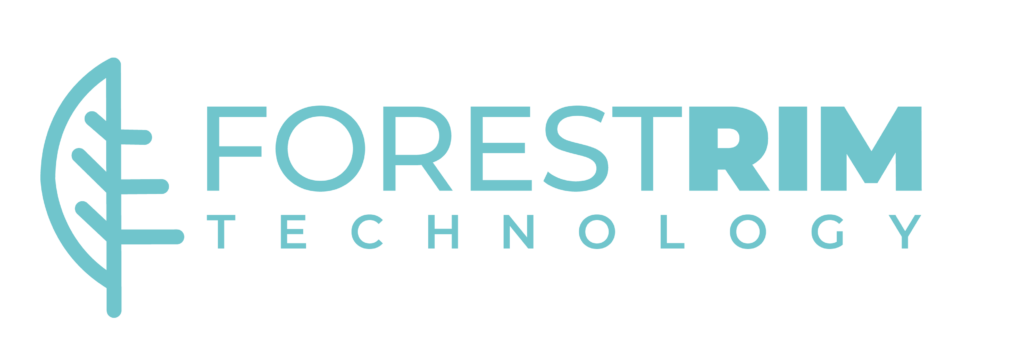Technology Reports
https://www.forestrimtech.com/guest-authors/Explore our Technology
Explore our Technology Reports: Data Architecture, Data Engineering, and Analytics.
In today’s dynamic technological landscape, Forest Rim and its esteemed partners offer extensive expertise in vital technologies. We’re eager to share this knowledge with you for a nominal fee, granting you access to unparalleled wisdom and boundless opportunities.
View our Guest Authors.
Reports:Data Architecture, Data Engineering, and Analytics
Tech Topics List
| Image | Title | Description | Guest Author |
|---|---|---|---|
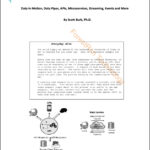 |
Data Architecture Part 1, Data in Motion, Data Pipes, APIs, Microservices, Streaming, Events and More | This is the first paper in a series of topics that are critical for you getting your data architecture right. We start with data in motion, understanding the piping, the way that data flows (moves). This is important to your data architecture plan and will impact how this data is stored. This paper is about the highways: when and how you move the vehicles along and where they are allowed to go. In the next paper we speak about ‘parking’ data, data stores. | Scott Burk, Ph.D. |
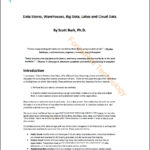 |
Data Architecture Part 2, Data Stores, Warehouses, Big Data, Lakes and Cloud Data | This is the second paper in a series of topics that are critical for you getting your data architecture right. We started with data in motion, understanding the piping, the way that data flows (moves). This is important to your data architecture plan and will impact how this data is stored. Now we focus on options to store or park data – this is data at rest. This is data that sits until we use it. This data is vital to all forms of analytics from interactive and visual BI to statistical analysis to AI and predictive machine learning models. In the next paper we will talk about data virtualization. | Scott Burk, Ph.D. |
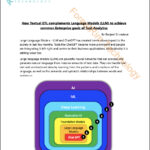 |
How Textual ETL complement Large Language Models (LLM) to achieve common Enterprise goals of Text Analytics | Large language models (LLMs) are revolutionizing natural language processing by handling raw and unstructured data through neural networks. But to crunch your data and provide insights, analytical tools need structured input data. That's where Textual ETL™ comes in, bridging the gap and making the whole process more efficient. Textual ETL uses algorithms for data disambiguation, stemming, stop words, and more to process raw textual and unstructured data like LLMs. What sets Textual ETL apart is its ability to convert unstructured and textual data into structured preferences, making it easily consumable by any analytical engine. You don't need to be an AI/ML expert to use Textual ETL, as it does it all for you. This tech topic is all about simplifying your data analysis with Textual ETL. | Ranjeet Srivastava |
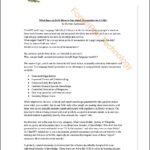 |
What Does an LLM Have to Say About Taxonomies for LLMs? | ChatGPT and Large Language Models (LLMs) are at the forefront of many people’s minds as these tools become more prominent and integrated into daily business life. As I am sure you are, I am always interested to see how AI develops and evolves. | Shawna Applequist |
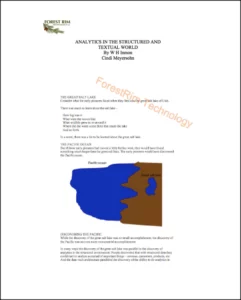 |
ANALYTICS IN THE STRUCTURED AND TEXTUAL WORLD | Trying to do analytical processing from a mixture of structured data and textual data is a challenge. This monograph addresses the issues behind trying to do analytics on multiple types of data and discusses techniques and approaches that work. Author: Bill Inmon and and Cindi Meyersohn | Cindi Meyersohn |
 |
ARCHITECTURE FOR THE DATA LAKE/DATA LAKEHOUSE | Corporations build data lakes only to find out that in short order the data lake turns into a sewer or a swamp. There is valuable information in the data lake but an architected approach is what is needed in order to unlock the value waiting there. Author: Bill Inmon | |
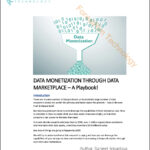 |
DATA MONETIZATION THROUGH DATA MARKETPLACE – A Playbook! | In today's digital age, data has taken center stage, often being compared to gold or the fuel that powers our modern world. As we stand amidst an unprecedented proliferation of data producers and consumers, the potential for harnessing and capitalizing on this data is immense. Yet, many enterprises grapple with unlocking the true value of their data assets. This article delves into the significance of data monetization and explores how organizations can effectively transform their raw data into tangible wealth. | Ranjeet Srivastava |
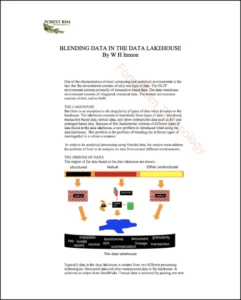 |
BLENDING DATA IN THE DATA LAKEHOUSE | There are three basic kinds of data in the data lakehouse – structured data, textual data and analog/IoT data. It is possible to have analytics done on all three types of data. This monograph discusses the issues and techniques that you need in order do analytical processing on the three different types of data found in the data lakehouse. Author: Bill Inmon | |
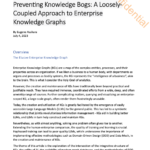 |
Preventing Knowledge Bogs: A LooselyCoupled Approach to Enterprise Knowledge Graphs | Enterprise Knowledge Graphs (KGs) serve as intricate maps of organizational entities and processes, akin to the "brain" of a business. Despite their value, their development has traditionally been daunting due to their complexity. However, with the advent of publicly accessible Large Language Models (LLMs), the creation and use of KGs have become more feasible, establishing a mutual relationship where KGs enhance LLMs and vice versa. Yet, the quality of LLM training remains paramount; ineffective training can lead to suboptimal LLMs, underscoring the significance of approaches like Domain-Driven Design (DDD) and Data Mesh in the realm of KGs. | Eugene Asahara |
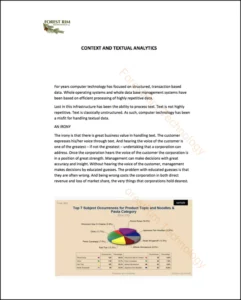 |
CONTEXT AND TEXTUAL ANALYTICS | Context is absolutely necessary to understand data. Context in the structured environment is found in the metadata that is used to build the infrastructure that houses structured data. But context for textual data is very different. This monograph describes the different kinds of context and how they compare and how they contrast. Author: Bill Inmon | |
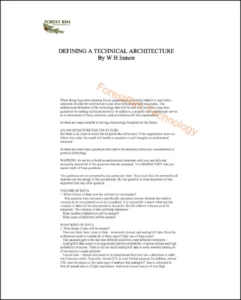 |
DEFINING A TECHNICAL ARCHITECTURE | On occasion it is desirable to define a technical architecture for an organization. This monograph discusses some of the major considerations of defining and creating a technical architecture for the organization. Author: Bill Inmon | |
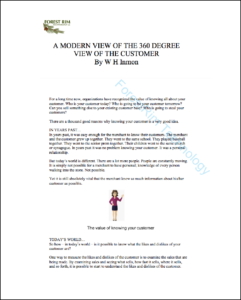 |
A MODERN VIEW OF THE 360 DEGREE VIEW OF THE CUSTOMER | For a long time now, organizations have recognized the value of knowing all about your customer. Who is your customer today? Who is going to be your customer tomorrow? Can you sell something else to your existing customer base? Who is going to steal your customers?... Author: Bill Inmon | |
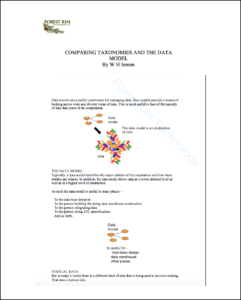 |
COMPARING TAXONOMIES AND THE DATA MODEL | Data models are a useful contrivance for managing data. Data models provide a means of looking across wide and diverse vistas of data. This is most useful in face of the panoply of data that exists in the corporation... Author: Bill Inmon | |
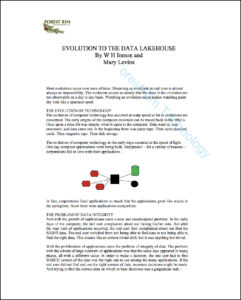 |
EVOLUTION TO THE DATA LAKEHOUSE | Most evolutions occur over eons of time. Observing an evolution in real time is almost always an impossibility. The evolution occurs so slowly that the steps in the evolution are not observable on a day to day basis. Watching an evolution occur makes watching paint dry look like a spectator sport... Authors: Bill Inmon and Mary Levins | Mary Levins |
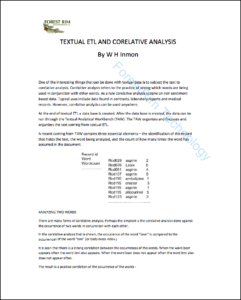 |
TEXTUAL ETL AND CORELATIVE ANALYSIS | One of the interesting things that can be done with textual data is to subject the text to corelative analysis. Corelative analysis refers to the practice of seeing which words are being used in conjunction with other words. As a rule corelative analysis is done on non sentiment based data. Typical uses include data found in contracts, laboratory reports and medical records. However, corelative analytics can be used anywhere... Author: Bill Inmon | |
 |
THE CANONICAL MODEL IN THE DATA LAKEHOUSE | The data lakehouse can contain three basic kinds of data. Those basic types of data are – Structured data Textual data Analog/IoT data....Each of these types of data has its own set of traits and characteristics. One way that the data can be compared and analyzed is by relative size. When it comes to volumes of data as a rule there is more textual data than there is structured data. And there is more analog/IoT data than there is textual data.... Author: Bill Inmon | |
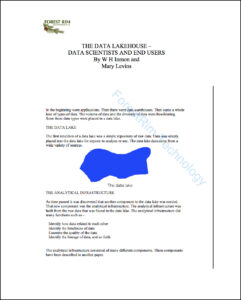 |
THE DATA LAKEHOUSE – DATA SCIENTISTS AND END USERS | In the beginning were applications. Then there were data warehouses. Then came a whole host of types of data. The volume of data and the diversity of data were bewildering. Soon these data types were placed in a data lake... Authors: Bill Inmon and Mary Levins | Mary Levins |
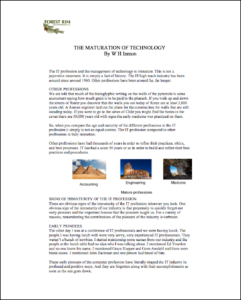 |
THE MATURATION OF TECHNOLOGY | The IT profession and the management of technology is immature. This is not a pejorative statement. It is simply a fact of history. The IT/high teach industry has been around since around 1960. Other professions have been around far, far longer... Author: Bill Inmon | |
 |
THE MODERN DATA WAREHOUSE | In the beginning were applications. Applications did a lot of repetitive work which would have to be done by humans were it not for the applications. As such corporations were very attracted to computerized applications. Applications saved tie, money and unnecessary work... Author: Bill Inmon | |
 |
THE STRUCTURED ENVIRONMENT | The first architectural environment that evolved was one known as the “structured environment”. The structured environment starts with the occurrence of an event. The event may be the making of a sale. Or the making of a telephone call. Or the payment of a bill. There are many different kinds of events that trigger a need for keeping track of the event. Some business event occurs and the information about that event causes the creation of a computerized record – Author: Bill Inmon | |
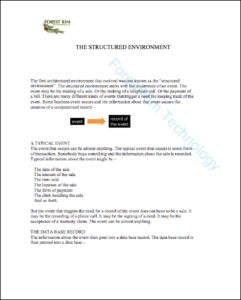 |
THE ANALYTICAL INFRASTRUCTURE FOR THE DATA LAKEHOUSE | Today we are retrieving data from applications, text and other unstructured data. The best way to collect that data is to place that diverse set of data into a into a data lake, or a data lakehouse. Two different technologies exist that make that collection of data into a lakehouse a reality. Those technologies are DataBricks which collects structured data and other unstructured data, and Forest Rim technology which collects text and turns text into a form that can be analyzed by the computer.... Author: Bill Inmon | |
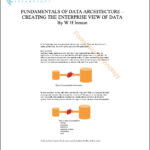 |
FUNDAMENTALS OF DATA ARCHITECTURE | Data architecture is at the foundation of AI, ML, data mesh and other technologies. Data architecture needs to encompass many facets of architecture. This monograph addresses why there is a need for data architecture and what are the shaping factors of the architecture.... Author – W H Inmon | |
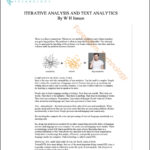 |
ITERATIVE ANALYSIS AND TEXT ANALYTICS | Text analytics are not done in a classical waterfall manner. Instead, text analytics are done in an iterative manner. But there are complex issues that arise when we do text analytics this way. This monograph discusses the issues facing the person needing to do text analytics. Author – W H Inmon | |
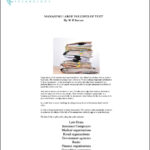 |
MANAGING LARGE VOLUMES OF TEXT | Author – it is absolutely normal for a person encounter a large volume of text when they start to do textual analytics. But the volume of text presents a real challenge to being able to do analytics against the text. This monograph discusses different approaches to the management of large volumes of text. Author – W H Inmon | |
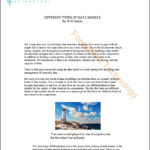 |
MULTIPLE DATA MODELS | There are different kinds of data models that serve different purposes. This monograph discusses what some of those data models look like and how they compare to each other. Author Bill Inmon. | |
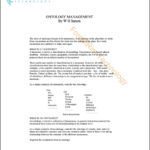 |
ONTOLOGY MANAGEMENT | Ontologies and taxonomies are one of the necessary ingredients for the disambiguation of text. But ontologies are constantly changing. This is the nature of the world – constant change. This monograph addresses the need for and the means of managing the change of ontologies over time. Author: Bill Inmon | |
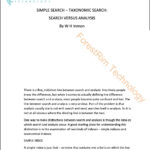 |
SIMPLE SEARCH – TAXONOMIC SEARCH | Simple searches are those that merely go out and find something. But there is a difference between search and analysis. Analysis requires a deep understanding of the context of whatever is being searched. This monograph describes the differences between a simple search and analysis. Author: Bill Inmon | |
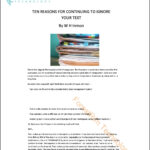 |
TEN REASONS FOR IGNORING YOUR TEXT | Text is everywhere and contains a wealth of business value. But most people ignore text. This paradoxical monograph is a satire and describes why people don’t look at text and what they are missing. Author Bill Inmon | |
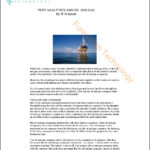 |
TEXT ANALYTICS AND OIL AND GAS | Oil and gas companies are full of text. They are so full that no one knows where anything is and how to find anything. This monograph describes the difference that a card catalog can make for an oil company. Author: Bill Inmon | |
